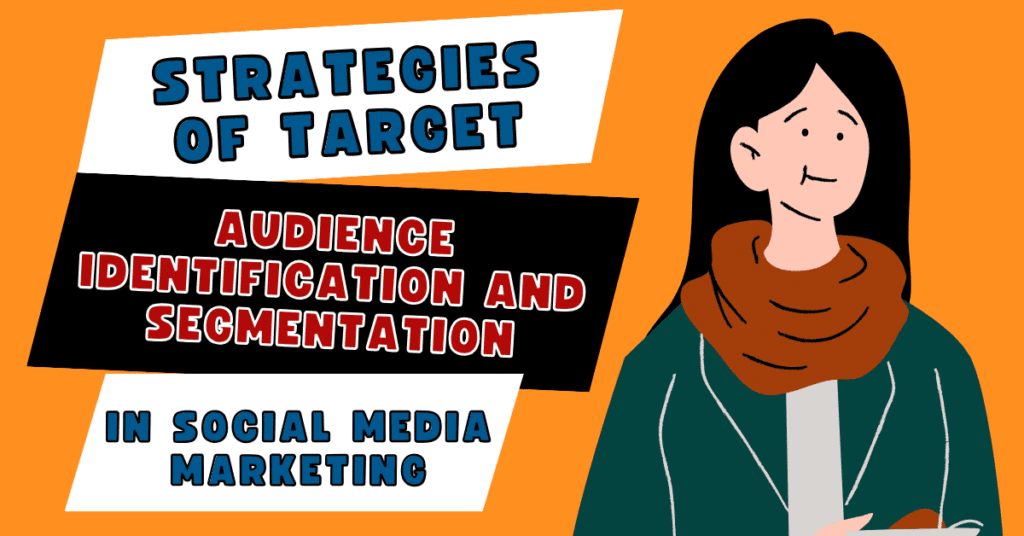
Strategies of Target Audience Identification and Segmentation in Social Media Marketing
- DCampaign Marketing
- Digital Marketing

Importance of Target Audience Identification and Segmentation in Social Media Marketing.
Target audience identification and segmentation are important in social media marketing as they allow businesses to create their messaging and content to specific demographics, interests, and behaviours. By understanding their audience, businesses can create more stable and personalized marketing campaigns, creating higher engagement, conversions, and overall success on social media platforms. Effective audience distribution also helps optimize advertising budgets by targeting only the most relevant audience segments for getting maximizing ROI.
The concept of target audience identification and segmentation
Target audience identification involves highlighting the specific demographics, interests, and behaviours of the people most likely to be interested in your product or service. Segmentation then divides this audience into smaller, more convenient groups based on shared characteristics. This process enables businesses to create their marketing efforts to different segments, resulting in more personalized and effective communication with potential customers on social media platforms.
Benefits of effectively identifying and segmenting your target audience
- Increased Relevance: Creating your marketing messages to specific audience segments ensures that your content resonates more deeply with each group, leading to higher engagement rates.
- Improved Conversion Rates: By understanding the unique needs and preferences of different audience segments, you can craft offers and calls to action that are more likely to convert leads into customers.
- Cost Efficiency: Targeted marketing reduces wastage by focusing resources on the most promising segments, maximizing the return on investment (ROI) of your marketing efforts.
- Enhanced Brand Loyalty: Personalized communication builds stronger connections with your audience, increasing brand loyalty and encouraging repeat purchases.
- Better Customer Insights: Audience segmentation provides valuable insights into consumer behaviour, allowing you to refine your products, services, and marketing strategies based on real data.
- Competitive Advantage: Businesses that effectively identify and segment their target audience can gain a competitive edge by delivering more relevant and compelling marketing messages than their competitors.
- Scalability: As your business grows, audience segmentation allows you to continue engaging with different customer segments effectively, even as your target audience expands.
- Adaptability: By continuously monitoring and refining your audience segments, you can adapt to changing market conditions and consumer preferences more quickly and effectively.
Importance of utilizing audience identification and segmentation strategies for business purpose
- Targeted Marketing: Aligning audience identification and segmentation helps focus marketing efforts on the most relevant audience segments, increasing the effectiveness of campaigns.
- Resource Optimization: By targeting specific audience segments, businesses can allocate resources more efficiently, avoiding wastage on irrelevant demographics.
- Customized Messaging: Tailoring messages to different audience segments allow for more personalized and resonant communication, leading to higher engagement and conversion rates.
- Improved ROI: When audience identification and segmentation strategies are aligned with business goals, the return on investment (ROI) from marketing activities tends to be higher due to better targeting and messaging.
- Competitive Advantage: Understanding your audience better than competitors enables you to offer more relevant products or services, gaining a competitive edge in the market.
- Product Development: Insights gained from audience segmentation can inform product development decisions, ensuring that offerings meet the specific needs and preferences of target segments.
- Brand Loyalty and Advocacy: Engaging with audiences in a targeted manner build stronger connections, leading to increased brand loyalty and advocacy among satisfied customers.
- Adaptability: Aligning audience strategies with business goals enables businesses to adapt more effectively to changing market conditions and enhancing customer preferences.
- Long-Term Success: A well fit alignment between audience identification, segmentation, and business goals fosters sustainable growth and long-term success by ensuring that all efforts are directed towards meaningful objectives.
Different approaches to target audience identification and segmentation
- Sales Growth: For businesses aiming to boost sales, identifying high-potential customer segments based on purchasing behavior and demographics can facilitate targeted marketing campaigns to drive conversions.
- Brand Awareness: Businesses focused on increasing brand awareness may prioritize broader audience segmentation, targeting various demographics to expand brand visibility through mass marketing channels.
- Customer Retention: Retaining existing customers often involves segmenting audiences based on their engagement levels and preferences, allowing for personalized communication and tailored loyalty programs.
- Market Penetration: When entering new markets, businesses may need to segment audiences based on cultural, geographic, or socioeconomic factors to adapt offerings and messaging to local preferences effectively.
- Product Innovation: Companies select for innovation may segment audiences based on psychographic traits and lifestyle preferences to identify unmet needs and opportunities for product development.
- Cost Efficiency: Businesses aiming to optimize costs may adopt a narrower audience segmentation approach, targeting high-value customer segments to maximize the return on marketing investment.
- Social Impact: Organizations with social impact goals may prioritize segmenting audiences based on values and beliefs, aiming to engage with like-minded individuals and communities to drive positive change.
- Market Leadership: Achieving market leadership often involves segmenting audiences to identify niche markets or underserved segments where the business can differentiate itself and establish dominance.
- Customer Satisfaction: Focusing on customer satisfaction may require segmenting audiences based on feedback and satisfaction levels, enabling personalized support and service offerings to address specific needs and concerns.
- Digital Presence: Businesses aiming to strengthen their digital presence may segment online audiences based on digital behavior and preferences, allowing for targeted digital marketing efforts and personalized online experiences.
How to Define Target Audience
Defining your target audience involves several major steps. First, analyze your product or service to identify its unique value position and who stands to benefit most from it. Next, conduct market research to understand the demographics, psychographics, and behaviours of potential customers. Finally, create detailed buyer personas that represent your ideal customers, incorporating insights from your research to tailor marketing strategies and messaging effectively. Regularly revisiting and refining this process ensures alignment with evolving business goals and market dynamics.
Significance of various factors in defining your target audience.
1. Demographics
- Identification: Demographics provide foundational information such as age, gender, income, education level, and geographic location, allowing businesses to identify and categorize their target audience more easily.
- Segmentation: Demographic data enables segmentation into distinct groups with shared characteristics, facilitating tailored marketing strategies and messaging to resonate with specific demographics.
- Market Sizing: Understanding demographic trends helps estimate the size and growth potential of target markets, informing strategic decisions related to market entry, expansion, and resource allocation.
- Accessibility: Demographic data helps businesses identify the most accessible channels for reaching their target audience, whether through traditional media, digital platforms, or in-person interactions.
2. Psychographics
- Deep Insights: Psychographics believes into the values, beliefs, lifestyles, interests, and personality traits of individuals, providing deeper insights into their motivations, preferences, and purchasing behaviors.
- Emotional Connection: Understanding psychographics allows businesses to create emotional connections with their audience by aligning messaging, branding, and offerings with their values and aspirations.
- Segmentation Refinement: Psychographic segmentation enables businesses to refine their target audience further beyond basic demographics, identifying niche segments with shared psychographic profiles for more personalized marketing.
- Brand Loyalty: By appealing to the underlying attitudes and emotions of consumers, psychographics can foster stronger brand loyalty and advocacy among those who resonate with a brand’s values and identity.
3. Behavioral Factors
- Actual Actions: Behavioral data captures actual actions and interactions of consumers, including purchase history, online browsing behavior, engagement with marketing campaigns, and brand interactions.
- Predictive Insights: Analyzing behavioral patterns allows businesses to predict future actions and preferences of their target audience, informing predictive modeling, recommendation systems, and targeted advertising strategies.
- Personalization: Behavioral data enables personalized marketing initiatives, such as targeted product recommendations, dynamic content delivery, and customized offers tailored to individual preferences and purchase intent.
- Conversion Optimization: By understanding the specific actions that lead to conversions, businesses can optimize their marketing funnels, website UX/UI, and customer journeys to remove barriers and drive more conversions effectively.
Segmentation & its importance in social media marketing
Segmentation in social media marketing involves dividing a target audience into various groups based on shared characteristics such as demographics, interests, behaviors, or psychographics. This allows marketers to create highly targeted and personalized content, ads, and messaging tailored to the preferences and needs of each segment. Effective segmentation enhances engagement, improves ROI, and fosters stronger connections with the audience by delivering relevant content that resonates with their interests and motivations.
What are the different segmentation criteria?
1. Demographics
- Age: Dividing the audience based on age ranges such as millennials, Gen X, or baby boomers.
- Gender: Segmenting by gender identity or preferences.
- Income: Categorizing based on income levels or household income.
- Education: Grouping by educational attainment or field of study.
- Occupation: Segmenting by profession, industry, or job title.
- Family Status: Dividing based on marital status, parental status, or household composition.
2. Psychographics
- Lifestyle: Segmenting based on hobbies, interests, and activities.
- Personality: Categorizing by personality traits such as introversion/extroversion or risk-taking behavior.
- Values: Dividing based on shared beliefs, attitudes, and ethical principles.
- Motivations: Segmenting by underlying psychological drivers and goals.
- Opinions: Grouping based on political views, social ideologies, or brand preferences.
3. Behaviors
- Purchase Behavior: Segmenting based on past purchase history, frequency, and spending habits.
- Engagement: Categorizing by levels of interaction with the brand, such as website visits, email opens, or social media engagement.
- Loyalty: Grouping based on loyalty status, repeat purchases, or membership in loyalty programs.
- Usage: Segmenting by frequency of product or service usage, heavy users vs. light users.
- Adoption of Technology: Dividing based on technology adoption rates and preferences, such as early adopters or laggards.
4. Geographic Location
- Country/Region: Segmenting based on country, state, city, or rural vs. urban areas.
- Climate: Categorizing by climate zones or weather conditions.
- Cultural Factors: Grouping based on cultural norms, language preferences, or traditions.
- Urbanization: Segmenting by population density and urban vs. rural living environments.
- Time Zone: Dividing based on time zone differences for targeted timing of marketing campaigns.
How businesses can segment their target audience effectively?
1. E-commerce Clothing Brand
- Segmenting by age groups to offer age-appropriate fashion collections.
- Utilizing purchase behavior data to create personalized recommendations.
- Tailoring marketing messages based on lifestyle interests such as fitness or travel.
2. Mobile App Developer
- Segmenting by app usage behavior to target power users for premium features.
- Categorizing based on geographic location to offer location-specific content or promotions.
- Utilizing psychographic data to engage with users based on their interests and motivations for app usage.
3. B2B Software Company
- Segmenting by industry verticals to customize product offerings and solutions.
- Targeting decision-makers based on job titles and organizational roles.
- Utilizing behavioural data to identify leads showing high intent and engagement for targeted outreach campaigns.
Tools and Techniques for Audience Identification
- Social Media Analytics Platforms: Tools like Facebook Insights, Twitter Analytics, and Instagram Insights provide valuable demographic, psychographic, and behavioral data about your followers and audience engagement.
- Audience Segmentation Tools: Platforms such as Hootsuite, Sprout Social, and Buffer offer audience segmentation features that allow marketers to categorize followers based on various criteria and tailor content accordingly.
- Customer Relationship Management (CRM) Systems: Integrating CRM systems like Salesforce or HubSpot with social media platforms enables businesses to track customer interactions, preferences, and purchase history across channels for more targeted marketing campaigns.
- Social Listening Tools: Tools like Brandwatch, Mention, and Sprout Social enable marketers to monitor social media conversations in real-time, gaining insights into audience sentiment, interests, and trending topics for more effective audience identification and engagement strategies.
Use of various social media tools for audience identification
- Social Media Analytics: Platforms like Facebook Insights and Twitter Analytics provide demographic, geographic, and behavioral data on your followers, helping identify key audience segments and understand their engagement patterns.
- CRM Software: CRM systems such as Salesforce and HubSpot integrate social media interactions with customer data, enabling businesses to build detailed profiles of their audience, track interactions across channels, and personalize marketing efforts based on individual preferences and behaviours.
- Third-party Tools: Tools like Sprout Social and Hootsuite offer advanced audience segmentation features, social listening capabilities, and sentiment analysis, allowing businesses to gain deeper insights into audience preferences, interests, and sentiments across social media platforms for more targeted marketing strategies.
Personalization and Customization in SMM
Personalization and customization are important in social media marketing as they enhance engagement, creating stronger connections with the audience, and drive conversions. By creating content, ads, and messaging to the specific interests, preferences, and behaviors of individual users, businesses can deliver more relevant and meaningful experiences. This not only increases the likelihood of capturing attention but also builds brand loyalty and advocacy, ultimately leading to long-term success in the competitive social media landscape.
How audience segmentation enables personalized messaging and content?
Audience segmentation allows businesses to distribute their target audience into various groups based on shared characteristics such as demographics, interests, and behaviors. By understanding these segments, marketers can create highly targeted and personalized messaging and content created to the unique needs and preferences of each group. This ensures that the right message reaches the right audience at the right time, leading to higher engagement, conversion rates, and overall marketing effectiveness.
In conclusion, effective target audience identification and segmentation are fundamental strategies for success in social media marketing. By using a combination of demographics, psychographics, behavior, and geographic factors, businesses can better understand their audience’s needs, preferences, and behaviors. Through personalized messaging and content tailored to specific audience segments, businesses can foster stronger connections, increase engagement, and drive conversions on social media platforms. Ultimately, the implementation of best selected audience identification and segmentation strategies is essential for maximizing the impact and ROI of social media marketing efforts in today’s competitive landscape.
Related Articles
Frequently Asked Questions
Identifying the target audience is essential because it helps businesses tailor their marketing efforts to reach the people who are most likely to be interested in their products or services. This targeted approach increases the chances of engagement, conversion, and ultimately, business success.
Some effective strategies include conducting market research to understand demographics, interests, and behaviors of potential customers, analyzing competitors’ audiences, leveraging social media analytics tools to gather insights about current followers, and engaging in active listening through social media monitoring to understand what topics and discussions are relevant to the target audience.
Segmentation involves dividing the target audience into smaller, more specific groups based on factors such as demographics, interests, behaviors, or buying habits. By segmenting the audience, marketers can create more personalized and targeted content that resonates with each group’s unique preferences and needs, leading to higher engagement and conversion rates.
Social media advertising allows businesses to reach a highly targeted audience based on various criteria such as demographics, interests, location, and behavior. This targeted approach ensures that marketing messages are seen by the people most likely to be interested in them, leading to better ROI, increased brand awareness, and higher conversion rates compared to traditional advertising methods.
Businesses can measure effectiveness by tracking key metrics such as engagement rates, click-through rates, conversion rates, and return on investment (ROI). Additionally, conducting regular audience analysis and gathering feedback through surveys or social media listening tools can provide valuable insights into whether the chosen target audience segments are responding positively to the marketing efforts.


